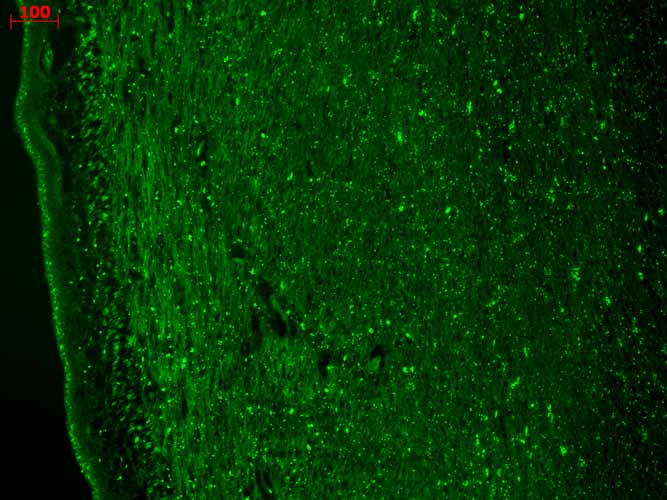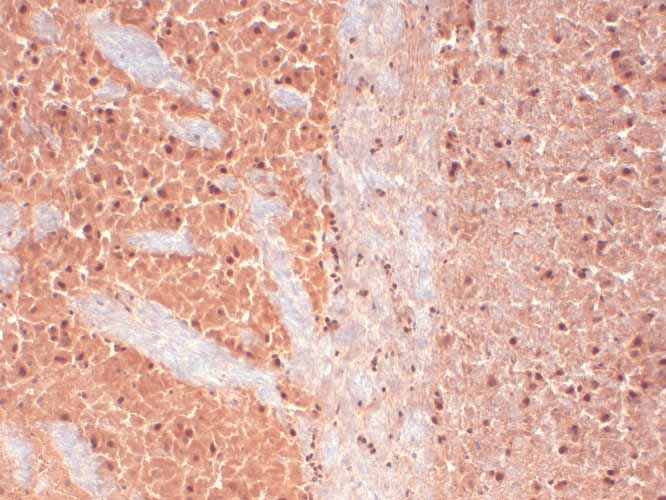Cav3.2 Antibody
Cav3.2 Antibody, Clone S55-10
- SPECIFICATION
- CITATIONS
- PROTOCOLS
- BACKGROUND

Application
| WB, IHC, ICC, AM |
|---|---|
| Primary Accession | O95180 |
| Other Accession | NP_001005407.1 |
| Host | Mouse |
| Isotype | IgG1 |
| Reactivity | Human, Mouse, Rat |
| Clonality | Monoclonal |
| Description | Mouse Anti-Human Cav3.2 Monoclonal IgG1 |
| Target/Specificity | Detects ~260kDa. No cross-reactivity against Cav1.3. |
| Other Names | Cav3.2 Antibody, CACNA1H Antibody, CACNA1HB Antibody, calcium channel Antibody, voltage-dependent Antibody, T type Antibody, alpha 1H subunit Antibody, calcium channel Antibody, voltage-dependent Antibody, T type Antibody, alpha 1Hb subunit Antibody, ECA6 Antibody, EIG6 Antibody, FLJ90484 Antibody, Low-voltage-activated calcium channel alpha1 3.2 subunit Antibody, low-voltage-activated calcium channel alpha13.2 subunit Antibody, voltage dependent t-type calcium channel alpha-1H subunit Antibody, voltage-dependent T-type calcium channel subunit alpha-1H Antibody, voltage-gated calcium channel alpha subunit Cav3.2 Antibody, voltage-gated calcium channel alpha subunit CavT.2 Antibody, Voltage-gated calcium channel subunit alpha Cav3.2 Antibody |
| Clone Names | S55-10 |
| Immunogen | Fusion protein amino acids 1019-1293 (II-III loop) of human Cav3.2 |
| Purification | Protein G Purified |
| Storage | -20ºC |
| Storage Buffer | PBS pH7.4, 50% glycerol, 0.09% sodium azide |
| Shipping Temperature | Blue Ice or 4ºC |
| Certificate of Analysis | 1 µg/ml of SMC-303 was sufficient for detection of Cav3.2 in 10 µg of HEK cell lysate expressing Cav3.2 by colorimetric immunoblot analysis using Goat anti-mouse IgG:HRP as the secondary antibody. |
| Cellular Localization | Membrane |

Thousands of laboratories across the world have published research that depended on the performance of antibodies from Abcepta to advance their research. Check out links to articles that cite our products in major peer-reviewed journals, organized by research category.
info@abcepta.com, and receive a free "I Love Antibodies" mug.
Provided below are standard protocols that you may find useful for product applications.
Background
CaV3.2 is a protein which in humans is encoded by the CACNA1H gene. Studies suggest certain mutations in this gene lead to childhood absence epilepsy (1, 2). Studies also suggest that the up-regulations of CaV3.2 may participate in the progression of prostate cancer toward an androgen-independent stage (3).
References
1. Chen Y., et al. (2003) Ann. Neurol. 54(2): 239–43.
2. Khosravani H., et al. (2004) J Biol Chem. 279(11): 9681-9684.
3. Gackiere F., et al. (2008) J Biol Chem. 283(28): 19872.
If you have used an Abcepta product and would like to share how it has performed, please click on the "Submit Review" button and provide the requested information. Our staff will examine and post your review and contact you if needed.
If you have any additional inquiries please email technical services at tech@abcepta.com.













 Foundational characteristics of cancer include proliferation, angiogenesis, migration, evasion of apoptosis, and cellular immortality. Find key markers for these cellular processes and antibodies to detect them.
Foundational characteristics of cancer include proliferation, angiogenesis, migration, evasion of apoptosis, and cellular immortality. Find key markers for these cellular processes and antibodies to detect them. The SUMOplot™ Analysis Program predicts and scores sumoylation sites in your protein. SUMOylation is a post-translational modification involved in various cellular processes, such as nuclear-cytosolic transport, transcriptional regulation, apoptosis, protein stability, response to stress, and progression through the cell cycle.
The SUMOplot™ Analysis Program predicts and scores sumoylation sites in your protein. SUMOylation is a post-translational modification involved in various cellular processes, such as nuclear-cytosolic transport, transcriptional regulation, apoptosis, protein stability, response to stress, and progression through the cell cycle. The Autophagy Receptor Motif Plotter predicts and scores autophagy receptor binding sites in your protein. Identifying proteins connected to this pathway is critical to understanding the role of autophagy in physiological as well as pathological processes such as development, differentiation, neurodegenerative diseases, stress, infection, and cancer.
The Autophagy Receptor Motif Plotter predicts and scores autophagy receptor binding sites in your protein. Identifying proteins connected to this pathway is critical to understanding the role of autophagy in physiological as well as pathological processes such as development, differentiation, neurodegenerative diseases, stress, infection, and cancer.



